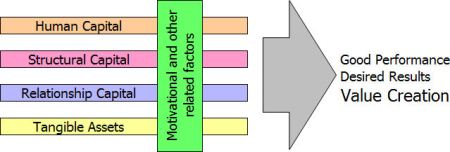Tangible versus Intangible Assets
지난 20년 동안 기업은 장부가치보다 시장가치가 훨씬 앞섰다. 그만큼 무형자산의 가치가 높다는 의미이다.
우리는 무형자산의 가치연구에 많은 시간을 할애하여야 하겠다. 무형자산이야 말로 미래의 자산이며 가치
창출의 엔진이기도 하기 때문이다.
I described in an earlier post (see: “KM is Not Enough!”) the factors that contribute to good
performance or value creation:

We must note the following to better grasp the intricacies of tangible and intangible assets:
- In the last two decades, market values of most corporations now far exceed their book values
(for example, as of December 12, 2008 the market-to-book ratios of 215 industry groups
listed in Yahoo! Finance averaged 4.458). This means that intangible assets are contributing
more than tangible assets in creating value. - There are many evidences across various sectors and disciplines that intangible assets are
more important than tangible assets in creating value (see previous post on “Intangibles: More
Essential for Value Creation”). - International accounting standards recognize “intangible assets” as such if they are: non-
physical, owned by the corporation, and can generate future economic benefits. Because of
the ownership criterion, many corporations do not consider the human capital they hired and
the intangibles that their personnel create (e.g. internally developed software and other
structural capital) as assets to be entered in their books of account, although these definitely
contribute to value creation by the corporation. In fact, training is often considered as a cost
item, instead of a capital investment item. The intangible assets commonly recognized by
accountants are: goodwill, brand, intellectual property rights like patents and copyrights,
licenses/franchises and similar legal agreements, etc.
- The intellectual capital accounting school of KM (e.g. Karl Erik Sveiby, Leif Edvinsson, Thomas
Stewart, Patrick Sullivan, Baruch Lev, etc.) recognizes three categories of intellectual capital:
human capital, structural capital and stakeholder capital (which includes customer capital
proposed by Hubert Saint Onge) – which contribute to value creation but are missed by
traditional accounting methods. These three categories are also recognized as “knowledge
assets”. Note, however, that stakeholder capital is only the externally-facing part of
Relationship Capital in the model diagrammed above (see next blogpost “D12- Relationship
Capital versus Stakeholder Capital versus Consumer Capital”). Elements of intellectual capital
are often not entered in books of accounts – a management gap which paved the way for
various methods of “intellectual capital accounting”, Kaplan and Norton’s Balanced Scorecard,
US Securities and Exchange Commission’s “colorized reports”, etc.
- Knowledge assets are mainly intangible and often not entered in books of accounts. A common
example of tangible knowledge assets is technology, which is a form of “embedded
knowledge”. Examples of knowledge assets not always entered in book of accounts are trade
secrets and internally developed patents (those that were not bought or sold by the
organization). - To encompass the wide range of factors (including natural capital, social capital, indigenous
knowledge, traditional or government-sanctioned access rights, cultural capital, etc.) that
contribute to value creation, whether tangible or intangible, whether measured or not by
accountants, we proposed the term “metacapital” (see the bottom of the previous post on
“Valuation of intangible assets”).
'이원모칼럼(Lee' Opinion)' 카테고리의 다른 글
| [The New York Times] 현명한 사람의 6가지 정신적 특징 (0) | 2014.09.03 |
|---|---|
| 성공의 지름길 (0) | 2014.06.05 |
| 실로 오랫만에 기대한 사람 (0) | 2014.05.22 |
| 八정도(正道)-바르게 가는 길 (0) | 2014.05.15 |
| 의사결정 五常의 행복 (0) | 2014.05.14 |
